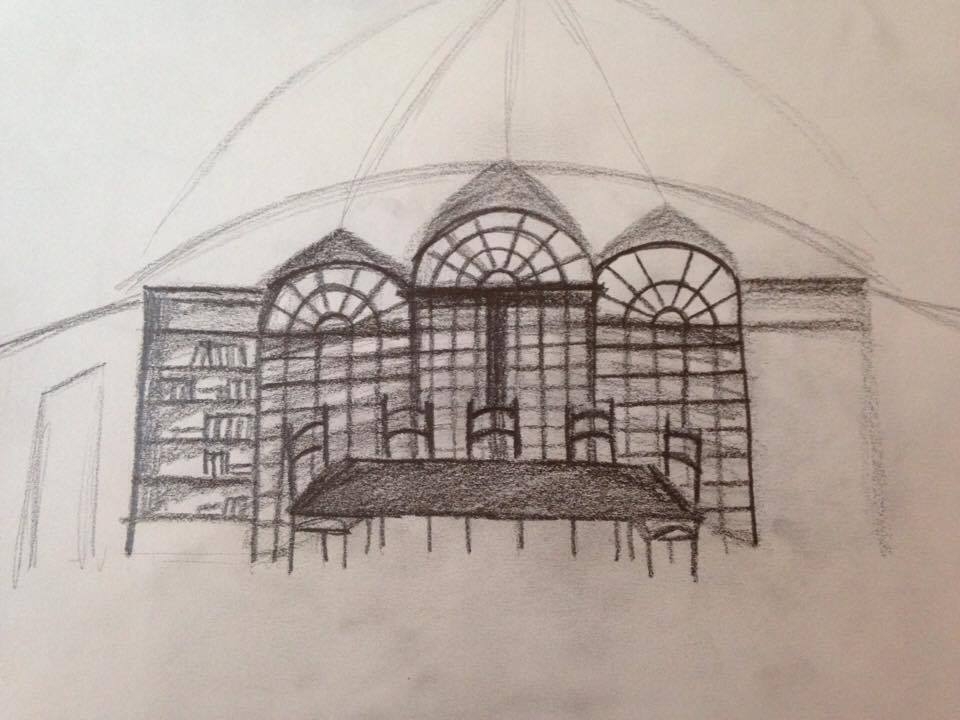“This vibrant play moves effortlessly between the centuries and explores the nature of truth and time, the difference between classical and romantic temperaments, and the disruptive influence of sex on our life orbits, the attraction Newton left out.”
Sydney Cheek-O’Donnell (dramaturg)
A dramaturg is the theatre artist who specializes in connecting a play to the performance context in which it will be performed. We do this in a variety of ways. One of the ways in which we do that is by conducting and sharing relevant research with our production team, actors, and audience. We typically do research on the play, the playwright, the content of the play, and the original context in which the play was written and performed. This information becomes creative source material for the theatre artists involved; and it can offer audiences ways to connect the play to their own lives and the world around them.
Arcadia, this took the form of an extensive glossary because the characters refer to dozens of historical figures, places, artistic movements, inventions, and scientific concepts. As with a Shakespeare play, the actors in Arcadia must understand what they are talking about so that they can help lead the audience through the story. The audience may not know exactly what the meaning of “determinism” is, for example, but if the actors understand it, they will be able to convey the significance or weight of it to the audience. The other part of my job is to watch the show in rehearsals at key moments (like run-throughs and dress rehearsals) and provide feedback to the director, with special attention on the clarity of the story telling.
I love this play. I think it’s probably one of the greatest plays—if not the greatest play—of the 20th century. The play addresses an astonishing variety of ideas, not just through the words the characters speak, but through the development of the play’s action, the way props are used and accumulate on stage, and the way characters parallel one another. The variety of complex ideas addressed in the play along with the sheer number of specific references the characters make to various historical figures, made simply developing a glossary an extremely challenging task. To create a good glossary, a dramaturg needs to process the information into bite-sized chunks that are clear and relevant to an actor. For a lot of plays, a glossary will only take a couple of days to put together. This one took me a couple of weeks. I think it ended up being in the neighborhood of 18 pages. So although it’s an extremely challenging text to work on, it’s also been a joy.
Macarena Subiabre (Stage Manager)
I was incredibly excited to start working on this show after reading the script. I love working with the people in the cast, many of which I have already worked with before, but have such different roles and challenges in this show. I also have really enjoyed seeing the process that the designers have had during this show, and seeing how their ideas all come together. This show is unique in the sense that there are so many props to keep track of. The scenes in this show are more intimate, and the connection between characters is incredibly important, which is what makes it so captivating. The show is also different in that every line said in this show is important, as it a clue to future scenes or it explains a previous action.
Haley Nowiki (Set Designer)
It has been a whole new experience for me designing the set for Arcadia. This is my third show at the U and it’s also the first show that takes place in another time period. I really enjoyed researching the architecture of the early 19th century and putting my own spin on things to create a more realistic experience for the audience. My favorite part of this set has got to be the floor. I worked with the scenic charge, Halee Rasmussen, and we painted it in the span of 2 days. It was so exciting to see a plain black stage floor transform into beautiful finished hard wood right in front of my eyes. It really ties the scene together for me. The whole set is so elegant and clean that it has become a stately home in our little basement theater. The most challenging part of this design was probably the research I had to do for it. I had to make sure that the elements I wanted to include were built correctly and were selling the right time period to the audience. Historical accuracy is important for a show like this one, so I had to make sure that I was digging deep to find the exact look I was going for, while still allowing me the freedom to mix and match ideas and include some of my artistry. It was pretty cool to design my own crown moulding and wainscoting, though.
Christa Didier (Costume Designer)
This show had a unique challenge of two different time periods, early 1800s and 1993. For the 1990’s, there were a lot of things I could skip; I already know from experience the types of fabrics that were used, the type of undergarments (which affects the silhouette ), and have a general sense of what “fits” the time and what doesn’t. I had to concentrate more on figuring out what was appropriate to each character, and what reads as British and aristocratic rather than middle class or American (Hint: American fashion was flashier and more unhinged.) It takes a lot of specific research to develop an instinct for what works and what doesn’t within a certain context, especially when the differences can be so subtle. I struggled with making things look British enough, particularly since my director, Sarah Shippobotham, is a native Brit who experienced the 90’s personally. She was always able to point out when something didn’t look quite right, even in such small of details as Valentine needing to unbutton his shirt collar.
As for the Regency research, I researched the type of structural undergarments that were used, fabric types, popular colors, accessories, silhouettes, appropriate fabric patterns, and a little bit of research of what came before and after. Something you have to keep in mind is that you usually won’t the luxury of getting to build every costume from scratch. It’s just not economical, especially in a show like this with 43 costumes. Out of those, I was only able to build part or all of the costume pieces for five looks, and sadly one of those actually ended up being cut from the show. The rest of the costumes must be pulled from existing storage, rented from other companies, or purchased and altered. I came up with an idea for a costume to use at the end of the show that was sort of “out there.” It’s more symbolic, less literal; sort of a wearable metaphor. Luckily, Sarah was on board when I explained the idea. I won’t spoil the ending for those who haven’t seen the show yet, but I will say I’m really satisfied with how it turned out. Initially this had very little to do with the play itself, but together in a very specific moment of the play, they conjure up powerful imagery and symbolism that I felt added depth and emotion to the scene.
Arcadia runs November 17-20 at 7:30 p.m. and 19 and 20 at 2:00 p.m. at the Babcock Theatre.
By: Kim Davison


